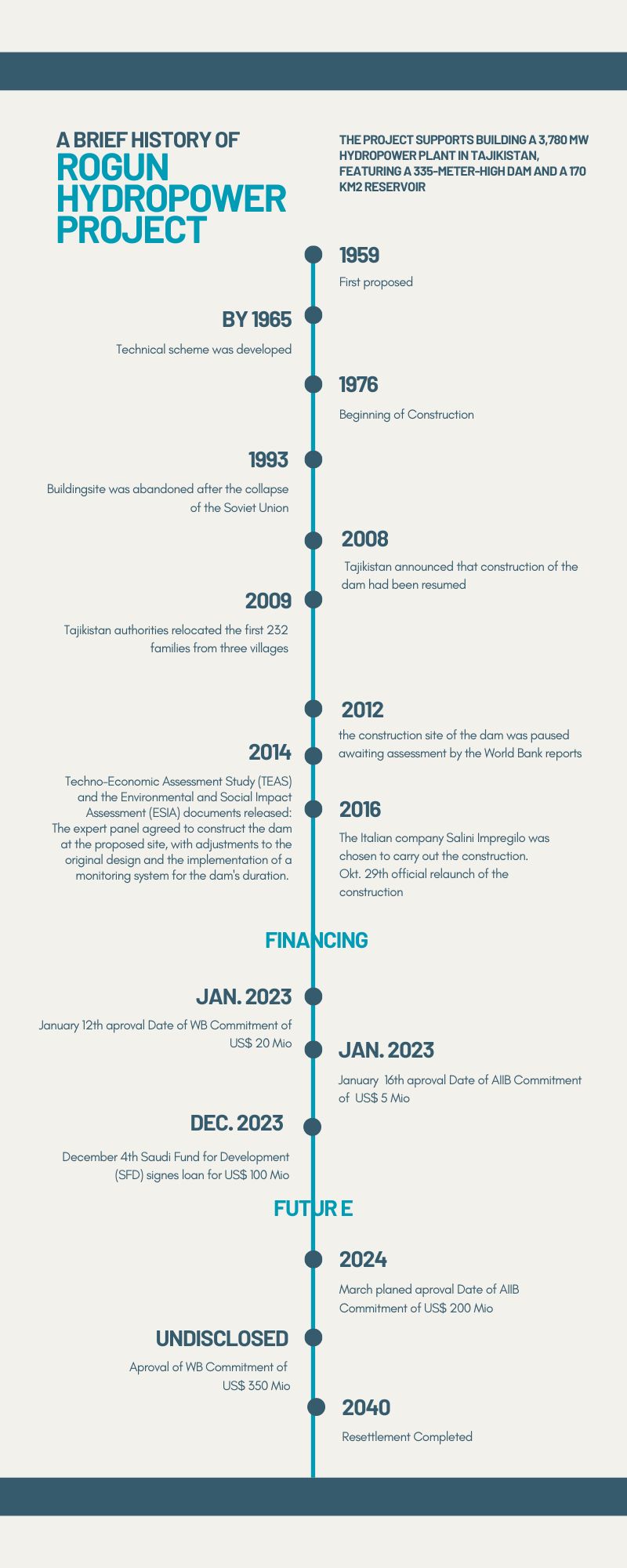Status: Approved
Timeframe: 2023- ?
Area: Tajikistan
AIIB Investment Amount: 500 million USD
Total Project Cost Completion: estimated at more than USD 6.4 billion (this does not include previous expenditure. The dam was built from 1976-1991 and from 2006-2024. The total cost of completing the project should include expenditures already made: USD 1.4 billion in Soviet times and USD 3.6 billion by Tajikistan)
Co-financier:
WB: 700 million USD
EIB: 550 million USD
ADB: 500 million USD
IsDB: 150 million USD
OPEC Fund: 100 million USD
Kuwait Fund for Arab Economic Development: 100 million USD
Abu Dhabi Fund for Arab Economic Development: 100 million USD
Saudi Fund for Development: 100 million USD
Bilateral Agencies (unidentified): 450 million USD
Borrowing Agency: 1250 million USD
Borrower: 2140 million USD
Provision of financial data shows discrepancies between the different co-financiers. All data used from the WB. WB also coordinates “Rogun Coordination Group” with Saudi-Arabian Development Bank, and 10 other development partners. Guarantee possible by EU. Associated infrastructure financed by ADB and EBRD.
E&S Category: A
Project details:
The project supports building a 3,780 MW hydropower plant in Tajikistan, featuring a 335-meter-high dam and a 170 km2 reservoir (the Three Gorges dam is "only" 185-meter high, and has a 1.085 km2 reservoir). It aims to enhance energy security, promote renewables, and improve cross-border connectivity. The reservoir is said to enable seasonal energy regulation and potential clean energy exports to Central Asia. In Phase 1, AIIB is considering an USD 269 million investment, with further phases reviewed later, based on progress.
Project Concerns:
Resettlement and Stakeholder engagement
According to the updated Environmental and Social Impact Assessment (ESIA) of 2023 the project leads to the involuntary resettlement of 46,628 people from 69 villages in Rogun, Nurobod, and Rasht districts. In a country marked by a dismal record in human rights and a high level of corruption this is particularly concerning.
Resettlement is carried out in phases the current phase two (until 2025) will resettle 13,000 people. The document fails to specify the number of affected villages and people who won't be resettled but will suffer from the project's impacts, e.g. income loss due to flooding of agricultural lands.
Phase one of resettlement has been highly problematic with Human Rights Watch finding resettled people without adequate compensation to restore their livelihoods and severe impacts on access to housing, food, water and education. However, the WB audit report of 2018 states all people have received adequate compensation.
Reports, as the one by Human Rights Watch, indicate declining living standards since resettlement due to land loss, lack of employment, and inadequate access to essential services. Homes of non-resettled people suffer damage from construction vibrations. Since 2015 there has been no independent report, including media coverage, on Rogun HPP in regard to resettlement.
Between 2008 and 2014, the World Bank made efforts to secure international financing for the Rogun HPP, which included five international regional consultations and numerous stakeholder engagement events. However, at present, there are no meaningful regional consultations held. The ESIA has not been fully disclosed, and there is a lack of new project materials available in the Tajik language on the website of the project proponents or the World Bank. This absence raises doubts whether free, prior, and meaningful consultations were conducted locally.
CEE Bankwatch submitted a comprehensive comment focussing on the social costs of Rogun to the Worldbank on April 14th 2024.
Carbon impact
With a carbon intensity of 102 grams of eCO2 annum/kwh, this hydropower project cannot be considered "green" and will not substantially aid in the decarbonization of Tajikistan's economy. Furthermore, if the completion timeframe extends beyond 2040, any regional climate mitigation plans relying on this project will be incompatible with the urgent need for timely climate action.
Biodiversity
Vakhsh River and Amu-Darya River are home to critically endangered fish species, namely two varieties of shovelnose sturgeon. However, the ESIA fails to evaluate the impacts on and the future well-being of these species.
The Tugay Forests within the Tigrovaya Balka World Heritage property are situated in the floodplain of the Vakhsh River, downstream from a hydropower cascade dominated by the Rogun HPP. Despite explicit requests outlined in the ESIA Terms of Reference (ToR), the resulting ESIA neglects to assess potential impacts and strategies for safeguarding these floodplain ecosystems through environmental flow management.
Water management
The Rogun reservoir, boasting an active capacity surpassing 10 cubic kilometers of water, holds the potential to significantly alter seasonal water flows within the Lower Vakhsh River and Amu-Darya River. Such alterations could precipitate environmental degradation and socio-economic crises. However, these prospective impacts are currently unaddressed in the ESIA, despite considerable public concern surrounding this matter.
The cumulative impact assessment of the project ignores the broader context of water resources management in the Amu-Darya Basin. This basin is currently facing a severe water crisis due to inadequately planned water infrastructure, both old and new. For instance, the ongoing construction of the Qosh-Tepa Canal in Afghanistan adds to these challenges.
Downstream populations in Tajikistan and neighboring countries face economic displacement from altered river flows caused by the Rogun HPP reservoir and other regional large-scale projects. The ESIA lacks analysis of their environmental and economic impacts, neglecting consultation with these communities. Approximately 10 million people depend on downstream river flows, facing potential negative environmental and economic consequences.
Financing
The IMF and the OECD have identified excessive expenditure on the Rogun HPP as having the most negative impact on other state investments in crucial infrastructure, healthcare systems, and education. The proposed "phased" financial arrangement is not solving but exacerbating this problem. Meanwhile, Tajikistan is gearing up to allocate up to 0.45 billion USD to this project in 2024.
Despite concerns the IMF signed a PCI deal with Tajikistan, giving it exemption to borrow non-concessional loans for Rogun specifically as it is "very important development project".
From 2006 to 2023, the projected total cost of constructing the Rogun HPP has surged from 3 to 9.6 billion USD, averaging a 15% annual increase. The Project Information Document indicates the likelihood of further cost escalations in 2024. The feasibility of completing the "tallest dam in the world" is increasingly questionable in terms of competitiveness against potential alternatives. However, these alternatives remain unexplored in the "updated ESIA."
Geopolitical concerns
The construction of the Rogun Dam has the potential to revive the legacy of geopolitical rivalry in the region. Historically, tensions between Tajikistan and Uzbekistan, driven by geopolitical, economic, and political factors, were once triggered by the Rogun Dam construction. Tajikistan prioritizes energy security, while Uzbekistan fears potential impacts on its crucial cotton sector and ecological equilibrium. Previous disputes disrupted economic activities, and the prospect of interstate conflict over the dam further complicates the situation. Climate change exacerbates these tensions by diminishing water supply. Economic apprehensions include risks to Uzbekistan's cotton industry and social opposition. Disagreements over water release timing underscore broader geopolitical and historical issues in the region.
Despite the current non-confrontational stance of Uzbekistan's leadership towards Tajik initiatives, the fundamental issue of water deficit and the substantial potential negative impact of the Rogun reservoir's filling and operation remain unresolved. The project's multifaceted concerns involve the potential for regional conflicts and environmental consequences.
CSO reports and organizations monitoring:
Climate Diplomacy, Rivers without Boundaries, CEE Bankwatch, NGO Forum on ADB, Green Alternative, CounterCurrent – GegenStrömung, International Rivers, ReCommon, CounterBalance
Rivers Without Boundaries Project Concerns and updated
Climate Diplomacy Conflict Analysis
Complaint by Rivers Without Boundaries to the World Bank
Further information:
Rogun Dam Exposed
AIIB Project Website
World Bank Project Website
World Bank, Key Issues for Consideration on the Proposed Rogun Hydropower Project
Constructors Project Website
Early Warning System Project Summery
Last update: 17.01.2025
Kontakt

Dr. Nora Sausmikat
Senior Campaigner Multilateral Development Banks, Focus AIIB / ADB
nora.sausmikat [at] urgewald.org
+49 030 86329 22 32

Dr. Dustin Schäfer
Team Lead Campaigns Multilateral Financial Institutions
dustin [at] urgewald.org
